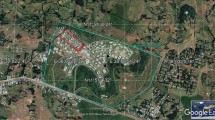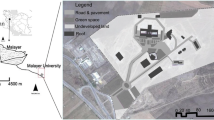Abstract
It is urgent to effectively mitigate flood disasters in humid mountainous areas in southeastern China for the increasing flood risk under urbanization and industrialization. In this study, a rural district with an area of 13.39 km2 that planning to build an industrial park covering an area of 7.98 km2 in Changting was selected to estimate the potential of collectable rainwater and the extent to which runoff volume can potentially be mitigated by rainwater harvesting. In addition, the optimum cistern capacity of a rainwater harvesting system in the planned industrial park was evaluated using daily water balance simulation and cost-efficiency analysis. The results showed that rainwater harvesting in the planned industrial park has great potential. The annually collectable rainwater is approximately 9.8 × 106 m3 and the optimum cistern capacity is determined to be 0.9 × 106 m3. With the optimum cistern capacity, the annual rainwater usage rate is 0.99, showing neither financial savings nor deficits. Rainwater harvesting can reduce 100 % of runoff volume in the cases of critical rainfall storm (50 mm) and annual average maximum daily rainfall (111.2 mm), and 58 % of runoff volume in the case of maximum daily rainfall (233.6 mm), respectively. All surface runoff can be collected and stored in the cisterns when rainfall amount is less than 135.5 mm in a rainstorm event.






Similar content being viewed by others
References
Ahiablame LM, Engela BA, Chaubey I (2013) Effectiveness of low impact development practices in two urbanized watersheds: Retrofitting with rain barrel/cistern and porous pavement. J Environ Manage 119:151–161
Braud I, Breila P, Thollet F et al (2013) Evidence of the impact of urbanization on the hydrological regime of a medium-sized periurban catchment in France. J Hydrol 485:5–23
Delgoda DK, Saleem SK, Halgamuge MN, Malano H (2013) Multiple Model Predictive Flood Control in Regulated River Systems with Uncertain Inflows. Water Resour Manage 27(3):765–790
Farmani R, Butler D (2014) Implications of Urban Form on Water Distribution Systems Performance. Water Resour Manage 28(1):83–97. doi:10.1007/s11269-013-0472-3
Farreny R, Gabarrell X, Rieradevall J (2011) Cost-efficiency of rainwater harvesting strategies in dense Mediterranean neighbourhoods. Resour Conserv Recycl 55(7):686–694
Ghisi E, Schondermark PN (2013) Investment Feasibility Analysis of Rainwater Use in Residences. Water Resour Manage 27(7):2555–2576
Ghisi E, Tavares DF, Rocha VL (2009) Rainwater harvesting in petrol stations in Brasilia: Potential for potable water savings and investment feasibility analysis. Resour Conserv Recycl 54(2):79–85
Hamel P, Dalya E, Fletcher TD (2013) Source-control stormwater management for mitigating the impacts of urbanisation on baseflow: A review. J Hydrol 485:201–211
He B, Wang Y, Takase K, Mouri G, Razafindrabe BH (2009) Estimating land use impacts on regional scale urban water balance and groundwater recharge. Water Resour Manage 23(9):1863–1873
He B, Kanae S, Oki T, Hirabayashi Y, Yamashiki Y, Takara K (2011) Assessment of global nitrogen pollution in rivers using an integrated biogeochemical modeling framework. Water research 45(8):2573–2586
Imteaz MA, Ahsan A, Naser J, Rahman A (2011) Optimisation of rainwater tank design from large roofs: A case study in Melbourne, Australia. Resour Conserv Recycl 55(11):1022–1029
Imteaz MA, Adeboye OB, Rayburg S et al (2012) Rainwater harvesting potential for southwest Nigeria using daily water balance model. Resour Conserv Recycl 62:51–55
Jacobson CR (2011) Identification and quantification of the hydrological impacts of imperviousness in urban catchments: a review. J Environ Manage 92(6):1438–1448
Kim J, Furumai H (2012) Assessment of Rainwater Availability by Building Type and Water Use Through GIS-based Scenario Analysis. Water Resour Manage 26(6):1499–1511
Kim G, Yur J, Kim J (2007) Diffuse pollution loading from urban stormwater runoff in Daejeon city, Korea. J Environ Manage 85(1):9–16
Lee J, Pak J, Yoo C et al (2010) Effects of land use change and water reuse options on urban water cycle. J Environ Sci 22(6):923–928
Ministry of construction of China (2006) Engineering technical code for rain utilization in building and sub-district (GB50400-2006). China Building Industry Press, Beijing, China [in Chinese]
Niemczynowicz J (1999) Urban hydrology and water management-present and future challenges. Urban Water 1(1):1–14
Peter MB, Deletic A, Urich C et al (2013) Modelling Interactions Between Lot-Scale Decentralised Water Infrastructure and Urban Form – a Case Study on Infiltration Systems. Water Resour Manage 27(14):4845–4863
Poff NL, Bledsoe BP, Cuhaciyan CO (2006) Hydrologic variation with land use across the contiguous United States: Geomorphic and ecological consequences for stream ecosystems. Geomorphology 79(3–4):264–285
Pottier N, Penning-Rowsellb E, Tunstall S et al (2005) Land use and flood protection: contrasting approaches and outcomes in France and in England and Wales. Applied Geography 25(1):1–27
Proenca LC, Ghisi E (2013) Assessment of Potable Water Savings in Office Buildings Considering Embodied Energy. Water Resour Manage 27(2):581–599
Qin ZM, Xu JG, Du KP (2011) Flood Risk Assessment of New District in Mountainous City - A Case Study of a Rare Earth Industrial Park in Longyan, Fujian Province. Proceedings of the Annual Conference of China Urban Planning, 2011. pp. 4968-4982. [in Chineses]
Rahman A, Keane J, Imteaz MA (2012) Rainwater harvesting in Greater Sydney: Water savings, reliability and economic benefits. Resour Conserv Recycl 61:16–21
Richert E, Bianchin S, Heilmeier H et al (2011) A method for linking results from an evaluation of land use scenarios from the viewpoint of flood prevention and nature conservation. Landsc Urban Plan 103(2):118–128
Shuster W, Rhea L (2013) Catchment-scale hydrologic implications of parcel-level stormwater management (Ohio USA). J Hydrol 485:177–187
Su M, Lin C, Chang L et al (2009) A probabilistic approach to rainwater harvesting systems design and evaluation. Resour Conserv Recycl 53(7):393–399
Suriya S, Mudgal BV (2012) Impact of urbanization on flooding: The Thirusoolam sub watershed – A case study. J Hydrol 412–413:210–219
Tam VWY, Tam L, Zeng SX (2010) Cost effectiveness and tradeoff on the use of rainwater tank: An empirical study in Australian residential decision-making. Resour Conserv Recycl 54(3):178–186
Wang XJ, Zhao RH, Hao YW (2011) Flood Control Operations Based on the Theory of Variable Fuzzy Sets. Water Resour Manage 25(3):777–792
Zhang XQ, Hu MC, Chen G, Xu YP (2012) Urban Rainwater Utilization and its Role in Mitigating Urban Waterlogging Problems—A Case Study in Nanjing, China. Water Resour Manage 26(13):3757–3766
Zuo JB, Liu CM, Zheng HX (2009) Cost-Benefit Analysis of Urban Rainwater Harvesting: A Case Study of Beijing. Resources Science 31(8):1295–1302 [in Chineses]
Acknowledgments
This work was supported by the Project Funded by the Priority Academic Program Development of Jiangsu Higher Education Institutions(PAPD).
Author information
Authors and Affiliations
Corresponding author
Rights and permissions
About this article
Cite this article
Zhang, X., Hu, M. Effectiveness of Rainwater Harvesting in Runoff Volume Reduction in a Planned Industrial Park, China. Water Resour Manage 28, 671–682 (2014). https://doi.org/10.1007/s11269-013-0507-9
Received:
Accepted:
Published:
Issue Date:
DOI: https://doi.org/10.1007/s11269-013-0507-9




